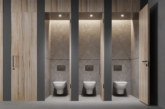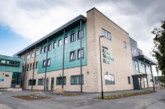Tony Rheinberg discusses Annex 2A and offers advice on how education specifiers can meet the grades in school washrooms.
Feeling safe and comfortable is so important for school children when visiting the washroom, especially for nursery and early years pupils who may still be developing their confidence around their own toilet routines. Decisions over what these environments look and feel like can have a significant impact on a child’s overall experience, and it’s important to note that much of this is regulated very explicitly in the UK.
In November 2017, the Government restructured and added to the legislation around the creation of school washrooms, including a new technical annex (Technical Annex 2A). This document, most recently updated in May 2019, covers sanitaryware requirements for all stages of education from early years through to primary and secondary schools, setting out new performance criteria.
Meeting these requirements has become mandatory for any project funded by the Education and Skills Funding Agency (ESFA). At Armitage Shanks, we aim to make it as easy as possible for schools to meet these requirements and our education product offering gives specifiers a wide range of solutions for all age groups, as well as literature for guidance. However, it’s crucial that decision-makers are aware of what standards they need to meet to ensure they specify the correct products. So, what do specifiers need to know to create compliant school bathrooms?
Better basins
Central to the new standards is the provision that any wash troughs or clusters of basins for all age groups need to have fully concealed plumbing. This is intended to maximise safety while also eliminating the risk of tampering. Annex 2A specifies that any wash troughs must be built out of a completely non-porous material, such as recycled plastic or china, which allows for an even and smooth surface and prevents the build-up of germs. Additionally, these basins need to be supported off the wall so there are no legs or other connections to the floor for ease of cleaning.
Armitage Shanks Contour 21 school troughs allow for total compliance with Annex 2A. Our 1,000mm 2-person and 1500mm 3-person wash troughs are free of sharp edges and built with hidden access panels which come in a variety of vibrant colours. This helps reduce the risk of accidents in the washroom and ensure pipework is concealed but accessible for servicing. They’re also made to reduce the risk of waterborne infection as both troughs are made of virtuous china making them quick and easy to clean. Their shape minimises the risk of splashing, reducing the spread of germs and damage to the surrounding washroom. At the same time these wash troughs are both fire retardant and UV stable, meaning they don’t bleach in sunlight.
When it comes to individual hand washbasins, much like the wash troughs, Annex 2A states that the pipework such as traps and waste pipes must be concealed within vanity units or other furniture. Engineers should be able to access maintenance equipment through a removable panel, using tamper-proof fixings. They also need to be able to meet the performance requirements set out in BS EN 14688:2015 to withstand the daily high-traffic in school environments.

Robust, compliant and economical
Another key thing to note in Annex 2A is the requirement that toilet pans and cisterns in schools, as well as the parts inside them all need to be sourced from a single manufacturer, helping improve standardisation and traceability. As with the aforementioned products, the internal components have to be concealed, tamper-proof, but accessible.
All toilets must be made out of china, or another material which can be demonstrated to work equally as well, and have internal overflow systems. They also require a dual-flushing capability which shall be either a 6/4 litre, 4.5/3 litre or 4/2.6 flush. The flushing mechanism itself should be a dual flush plate with separate buttons for low and standard volume flush. In terms of performance, it must comply with the Water Regulation Guide WRAS as well as the UK Class 2 Flush Test. The toilet seats and lids chosen for schools all need to be top fitting and made in accordance with BS 1254:1981.
Installation is key
The new regulations make it clear that handwashing taps in schools need to be easy to use, hygienic, durable and water-efficient. This means the specification of non-concussive press taps (ones which turn themselves off after a certain amount of time) is a good option. These taps can be adjusted to give a longer or shorter run time, helping deliver the optimum amount of water. Alternatively, sensor taps are another viable product which will deliver the desired specification of water. When installed, Annex 2A requires that deck mounted taps must allow for an even surface when fixed to the sink or trough, so they can be cleaned effectively. Alternatively, taps can be wall mounted, as long as there is the necessary level of robust wall panelling that conceals the system.
Accessible and safe
Creating the right environment for accessible toilets is crucial within schools when making spaces for children and younger adults who are less independent. The new Annex 2A document states that washrooms must include accessible cisterns with tamper proof plates to avoid both dirt and bacteria build-up. Additionally, visually distinctive, contrasting colours must be used on products such as sanitaryware, grab rails and alarm cords. This is to allow people with visual impairments to locate the fittings. At the same time the toilet seat should be in a contrasting colour so visually impaired people can see if it is up or not.
Colour and contrast in inclusive bathrooms are areas in which Armitage Shanks has been investigating for a number of years, which is why we’ve created our enhanced Doc M offering which guarantees compliance in schools and a better solution for those with sight loss. Research we’ve conducted has found the colour red is more easily seen than other colours by those living with visual impairments.
Better looking washrooms
Research suggests that children are often more reluctant to use toilet facilities when they are unattractive and even reduce their intake of fluids so they can avoid visiting the toilet. With this in mind, it is imperative that designers and specifiers equip washrooms with welcoming and softer aesthetics. For example, Armitage Shanks’ Splash range is designed with bright colours and child friendly features such as easy open seats and green eco buttons, appealing to younger children to promote positive bathroom behaviour.
Tony Rheinberg is Senior Sector Marketing Manager at Ideal Standard









